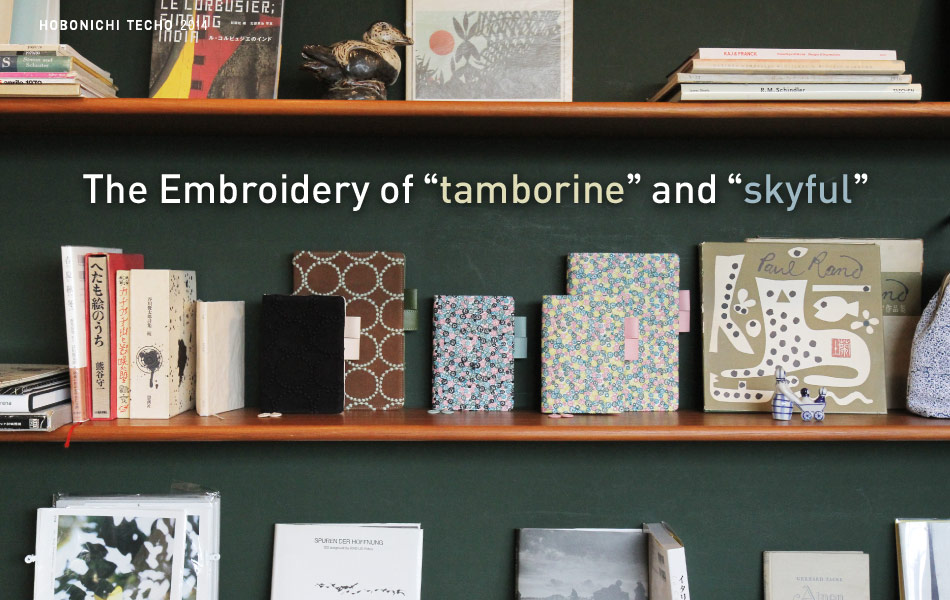The introduction of machines transformed embroidery from something free-form and hand-crafted—uneven, bumpy—into something stiff and uniform. I was hoping to create something reminiscent of hand-embroidery while still relying on the power of machines. I could feel the potential behind embroidery, so I drew up a sketch and tried to embroider over it. I figured it’d be easier to see if I created simple shapes, and that’s how I came up with the design for tambourine.

tambourine first debuted in minä perhonen’s Autumn-Winter 2000 collection. The textile featured beige fabric embroidered with brown thread to give it a warm feel that worked well in dresses and other items.
When embroidering the otherwise simple circle, I took something that would usually be formed into a perfect, uniform shape and created dots that were all embroidered individually to give every single one its own unique shape. This way, it looks uniform from far away, but up close, you can see the different shapes of every dot.

Look closely, and you can see how the threads of each dot have different directions and layering to make each one a unique size and shape.
tambourine’s embroidery protrudes by piling up threads in concentrated spots. This takes up more time and manpower, but we treat our embroidery with raised relief to create three-dimensional patterns.

Running the needle over the same spot several times gives the embroidery thread its pop. It takes more time to layer threads this way, with fifteen yards of material taking about four hours.
We have an old textile called “galileo” that was designed by drawing a ton of stars by hand, and I wanted to try turning it into embroidery. I thought that I could embroider a star if it wasn’t the typical five-pointed shape everyone thinks of. I gave it a shot, and it came out as something that also resembles a flower, so it’s a really neat textile.

skyful is based on this old design, galileo, which packs together an endless number of stars Minagawa drew by hand.
I’ve made a lot of embroidered textiles in my time, but never have I created one with embroidery that’s so tightly packed across the entirety of the cloth. I didn’t want the design to be simple, so I used techniques like having the threads bulge out like in tambourine, and using a special scalpel to open holes and sew up the edges.

During the development of the design, there were problems of the material shrinking more than expected after covering the entire thing with embroidery. The elasticity of the fabric also changes depending on the climate, so this is one of the textiles constructed through meticulous consideration.
Since this textile is modeled after a clear, starry night sky, I used blue and green threads made of rayon for a glossy sheen, and pink and yellow threads made of cotton. There’s a very different feel to the “yellow mix” and “blue mix” options, but actually, the only difference is the yellow threads being replaced by black ones. These make all the difference in how the pink colors stand out. The interactions between colors are really important, because the dymanics can really change based on which colors are placed next to each other.

By using both cotton and rayon threads, the luster of the rayon is pronounced to give it the feel of stars twinkling in the night sky.
The complicated and elaborate embroidered textiles of minä perhonen are manufactured in a lace factory in the mountains of Kanagawa Prefecture.

From Monkicho 12SS Photo: L.A.TOMARI
Production of their embroidered textiles begins with a sketch by Minagawa. The sketch includes Minagawa’s ideas such as which circles are flat, which circles will protrude, which direction a leaf blows in the wind, and so on.
Satou from the lace factory has been making embroidered textiles with Minagawa for over twenty years. Based on their long experience together, Satou can pick out Minagawa’s vision based on such things as the darkness and thickness of the lines in his sketches. Satou then sets up the programming as if breathing life into the machines.

From Monkicho 12SS Photo: L.A.TOMARI
The embroidery of minä perhonen is designed in a way that emulates the uneven and intricate nature of hand-embroidery, so the machines are set at one-third the normal speed to allow slow, careful needlework.

From Monkicho 12SS Photo: L.A.TOMARI
Once the sketch for an embroidery pattern is complete, Minagawa heads right to the lace factory. He meets with Satou to show his concept and discuss how they can create something true to the sketch. Minagawa tells us how important it is that they meet face to face so they can use both images and words to bring the image together.

From Monkicho 12SS Photo: L.A.TOMARI
Minagawa and Satou go through many stages of painstaking exchanges to perfect the design. Once they reach a point where everyone is pleased with the results, a minä perhonen embroidery textile is finally complete.















